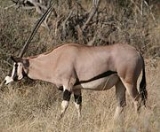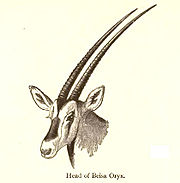
East African Oryx
Encyclopedia
The East African Oryx also known as the Beisa occurs in two subspecies
, Common Beisa Oryx (Oryx beisa beisa) found in steppe
and semi-desert throughout the Horn of Africa
and north of the Tana River
, and Fringe-eared Oryx (Oryx beisa callotis) south of the Tana River in southern Kenya
and parts of Tanzania
. In the past, some taxonomists
considered it a subspecies of the Gemsbok
(Oryx gazella), but they are genetically distinct; the diploid chromosome count is 56 for the Beisa and 58 for the Gemsbok.

 East African Oryx stand just over a metre at the shoulder and weigh
East African Oryx stand just over a metre at the shoulder and weigh
around 175 kilograms. They have a grey coat with a white underside, separated from the grey by a stripe of black, there are also black stripes where the head attaches to the neck, along the nose and from the eye to the mouth and on the forehead. There is a small chestnut coloured mane. The ringed horns are thin and straight. They are found on both sexes and typically a measure of 75–80 cm is considered big. Comparably, the Gemsbok has an entirely black tail, a black patch at the base of the tail, and more black on the legs (including a patch on the hindlegs) and lower flanks. The smaller Arabian Oryx
is overall whiter with largely dark legs.
East African Oryx live in semi-desert and steppes where they eat grass
, leaves
, fruit
and bud
s. East African Oryx are able to store water by raising their body temperature (so as to avoid perspiration). They gather in herds of five to forty animals often with females moving at the front and large male guarding from the rear. Some older males are solitary. Radio tracking studies show that solitary males are often accompanied for brief periods by breeding condition females, so it is probable they are executing a strategy to maximise their chances of reproduction.
Subspecies
Subspecies in biological classification, is either a taxonomic rank subordinate to species, ora taxonomic unit in that rank . A subspecies cannot be recognized in isolation: a species will either be recognized as having no subspecies at all or two or more, never just one...
, Common Beisa Oryx (Oryx beisa beisa) found in steppe
Steppe
In physical geography, steppe is an ecoregion, in the montane grasslands and shrublands and temperate grasslands, savannas, and shrublands biomes, characterized by grassland plains without trees apart from those near rivers and lakes...
and semi-desert throughout the Horn of Africa
Horn of Africa
The Horn of Africa is a peninsula in East Africa that juts hundreds of kilometers into the Arabian Sea and lies along the southern side of the Gulf of Aden. It is the easternmost projection of the African continent...
and north of the Tana River
Tana River (Kenya)
The long Tana River is the longest river in Kenya, and gives its name to the Tana River District. Its tributaries include the Thika. The river rises in the Aberdare Mountains to the west of Nyeri. Initially it runs east before turning south around the massif of Mount Kenya. The river then runs...
, and Fringe-eared Oryx (Oryx beisa callotis) south of the Tana River in southern Kenya
Kenya
Kenya , officially known as the Republic of Kenya, is a country in East Africa that lies on the equator, with the Indian Ocean to its south-east...
and parts of Tanzania
Tanzania
The United Republic of Tanzania is a country in East Africa bordered by Kenya and Uganda to the north, Rwanda, Burundi, and the Democratic Republic of the Congo to the west, and Zambia, Malawi, and Mozambique to the south. The country's eastern borders lie on the Indian Ocean.Tanzania is a state...
. In the past, some taxonomists
Taxonomy
Taxonomy is the science of identifying and naming species, and arranging them into a classification. The field of taxonomy, sometimes referred to as "biological taxonomy", revolves around the description and use of taxonomic units, known as taxa...
considered it a subspecies of the Gemsbok
Gemsbok
The gemsbok or gemsbuck is a large antelope in the Oryx genus. It is native to the arid regions of southern Africa, but formerly some authorities included the East African Oryx as a subspecies...
(Oryx gazella), but they are genetically distinct; the diploid chromosome count is 56 for the Beisa and 58 for the Gemsbok.


Weight
In science and engineering, the weight of an object is the force on the object due to gravity. Its magnitude , often denoted by an italic letter W, is the product of the mass m of the object and the magnitude of the local gravitational acceleration g; thus:...
around 175 kilograms. They have a grey coat with a white underside, separated from the grey by a stripe of black, there are also black stripes where the head attaches to the neck, along the nose and from the eye to the mouth and on the forehead. There is a small chestnut coloured mane. The ringed horns are thin and straight. They are found on both sexes and typically a measure of 75–80 cm is considered big. Comparably, the Gemsbok has an entirely black tail, a black patch at the base of the tail, and more black on the legs (including a patch on the hindlegs) and lower flanks. The smaller Arabian Oryx
Arabian Oryx
The Arabian Oryx or White Oryx is a medium sized antelope with a distinct shoulder hump, long straight horns, and a tufted tail. It is a bovid, and the smallest member of Oryx genus, native to desert and steppe areas of the Arabian peninsula...
is overall whiter with largely dark legs.
East African Oryx live in semi-desert and steppes where they eat grass
Grass
Grasses, or more technically graminoids, are monocotyledonous, usually herbaceous plants with narrow leaves growing from the base. They include the "true grasses", of the Poaceae family, as well as the sedges and the rushes . The true grasses include cereals, bamboo and the grasses of lawns ...
, leaves
Leaves
-History:Vocalist Arnar Gudjonsson was formerly the guitarist with Mower, and he was joined by Hallur Hallsson , Arnar Ólafsson , Bjarni Grímsson , and Andri Ásgrímsson . Late in 2001 they played with Emiliana Torrini and drew early praise from the New York Times...
, fruit
Fruit
In broad terms, a fruit is a structure of a plant that contains its seeds.The term has different meanings dependent on context. In non-technical usage, such as food preparation, fruit normally means the fleshy seed-associated structures of certain plants that are sweet and edible in the raw state,...
and bud
Bud
In botany, a bud is an undeveloped or embryonic shoot and normally occurs in the axil of a leaf or at the tip of the stem. Once formed, a bud may remain for some time in a dormant condition, or it may form a shoot immediately. Buds may be specialized to develop flowers or short shoots, or may have...
s. East African Oryx are able to store water by raising their body temperature (so as to avoid perspiration). They gather in herds of five to forty animals often with females moving at the front and large male guarding from the rear. Some older males are solitary. Radio tracking studies show that solitary males are often accompanied for brief periods by breeding condition females, so it is probable they are executing a strategy to maximise their chances of reproduction.

